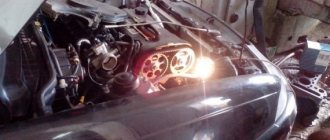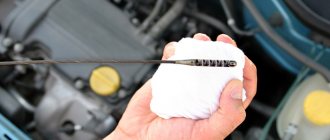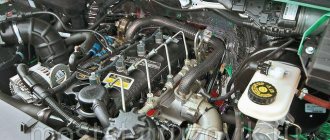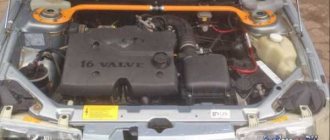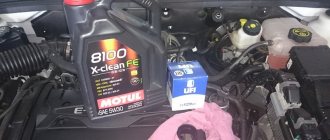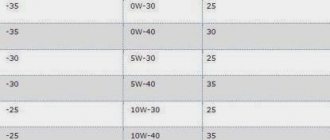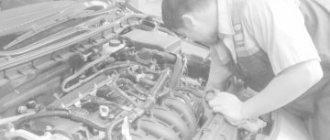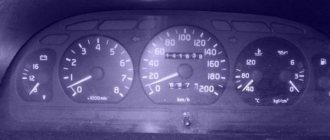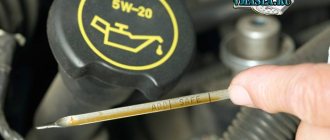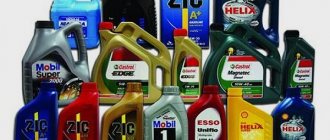To adjust the ignition timing depending on the temperature state of the engine, the control unit receives information from two identical semiconductor sensors of type 19.3828.
The sensor installed in the thermostat housing boss is designed to determine the temperature of the engine coolant.
Another sensor installed in the intake pipe in the area of the fourth cylinder determines the temperature of the air entering the cylinders.
The sensors are included in the electronic circuit of the control unit, which (depending on the temperature of the coolant and incoming air) adjusts the ignition timing. If a malfunction occurs in the sensor or in its circuits, the control unit signals by turning on the warning lamp. This causes errors in the operation of the engine control system. A faulty coolant temperature sensor further complicates engine starting. The serviceability of the sensor is checked using the DST-2 device, and in its absence, by the magnitude of the voltage drop in the sensor circuit at different temperatures.
You will need: a thin screwdriver or an awl, a 19" wrench.
1. To remove the coolant temperature sensor, disconnect the wiring harness connector from the sensor connector by releasing the spring lock.
2. Unscrew the sensor from the thermostat housing.
3. Similarly, remove the incoming air temperature sensor.
Rice. 9.9. Electrical circuit for checking the temperature sensor: 1 – variable resistance 10 kOhm; 2 – battery;
3 – voltmeter; 4 – milliammeter; 5 – sensor
To check, you need to assemble a circuit (see Fig. 9.9). Using resistance 1 and milliammeter 3, set the current in the circuit to 1–1.5 mA. At a temperature of +25 °C, voltmeter 4 should show a voltage of 2.957–3.022 V. By changing the ambient temperature of the sensor, measure the voltage drop with voltmeter 4. For a working sensor, it should be within the following limits: +40 °C – 2.287–2.392 V +90 ° C – 3.642–3.737 V. Replace the faulty sensor.
4. Install the sensors in the reverse order of removal. When installing the coolant temperature sensor, lubricate its threads with sealant.
GAZ 31105 has been produced by the Gorky Automobile Plant since 2004, and since 2006 the car began to be equipped with an American 2.4-liter Chrysler engine. The engine has been produced in America since 1995, and before that it was installed on many American cars.
Classic design of the Volga Gaz 31105 car
Review of GAZ-31105 "Volga"
The Volga-31105 car is the latest generation of the model range of passenger cars produced by GAZ. The car was equipped with such well-known engines as 24, 402, 405, 406 and 505. During the development process, an engine from Chrysler was installed as an experiment. But, since it worked, the plant management decided to introduce the technology into mass production.
Of course, the new Volga with a Chrysler engine was no different in interior and exterior from standard cars with the 406 engine. The only modification was the installation of a different power unit, which appealed to many car enthusiasts. Naturally, not everyone appreciated the improvement, and there were drivers who condemned the innovation, because, in their opinion, the Volga should have remained itself.
The interior received minor changes. For the first time, a multifunction steering wheel was installed, which made it possible to control the audio system. The engineers also added the ability to adjust the steering wheel position. The interior trim was completely replaced with a new one, this is how Chryslers are designed as standard. The owners benefited from the new changes, as the Volga became more comfortable and cozy.
You can only buy a car on the used car market, since its production ceased in 2009, when the plant decided that the production of this car should be discontinued due to a 2-fold drop in sales.
Description
The Chrysler 2.4 DOHC EDZ engine is a power unit proven by many years of practice, mass-produced since 1995. Structurally, it is an in-line 4-cylinder 16 valve engine with multipoint fuel injection and a DOHC gas distribution mechanism.
Conceptually similar to domestic ZMZ engines, it has significantly less weight and a larger cylinder capacity. The Americans achieved this by designing a thin-walled cylinder block from high-strength cast iron, and its head (cylinder head) from aluminum.
The role of the base of the cylinder block is performed by a closing steel plate, which provides the necessary rigidity and durability of the structure as a whole. Such a plate further reduces the risk of resonant oscillations of the Chrysler engine during operation.
The use of:
- pistons with reduced skirt height;
- original shaped piston rings;
- plastic intake manifold;
- thin-walled exhaust manifold;
- plastic cylinder head cover, etc.
The timing belt is driven by a toothed belt. During the development process, the designers paid a lot of attention to eliminating vibrations and noise. To reduce engine vibrations during operation, balancing shafts are provided, stabilizing the functioning of the crank group and reducing vibration loads on the supports of the power unit. They are driven by a steel roller chain.
Additionally, the motor is equipped with a special flywheel with a built-in damping device that reduces transmission vibrations. The power unit crankcase is made of two layers of steel, which significantly reduces the noise of operating mechanisms. In addition, a special noise-absorbing screen is installed under the gearbox.
The American power unit also stands out because of its original exhaust system, equipped with a catalytic converter and rubber suspension elements.
The operation of the Chrysler engine (fuel injection, ignition, etc.) is controlled by an electronic control unit (ECU), the parameters of which are adapted to domestic operating conditions.
Technical characteristics of GAZ-31105 with Chrysler engine
GAZ-31105 Volga received a new improved Chrysler engine, which added power and dynamic data. Of course, some structural elements had to be slightly modified, but the manufacturer coped with this task perfectly.
"Volga-31105", the Chrysler engine on which was installed, received new technical characteristics. To use the car's full potential, a 2.4 Dohc Daimler Chrysler engine was installed, which had a power of 137 horsepower. Since the old gearbox was unable to function with this engine, the designers had to develop a new 5-speed manual gearbox, which was equipped with new bearings to more efficiently use the potential of the internal combustion engine.
Also, the GAZ-31105 Volga was able to reduce the acceleration time from 0 to 100 km, and this figure was only 11 seconds. This meant that the new engine was more powerful than its domestic counterpart. The maximum speed that the Volga-31105 developed (the Chrysler engine was the driving force) was 178 km/h.
The new Volga was more economical compared to its counterparts. So, the average fuel consumption was about 9 liters, while on the highway it was 7.8 liters, but in the city it was 10.8 liters. This is about 1-1.5 liters less than with the 405 or 406 engine.
Volga-31105 (Chrysler engine) was produced only briefly, from 2007 to 2009, but during this short period of time it managed to gain an army of fans.
Oil in Volga Chrysler
Am I doing it right when I pour synthetics?
If I switch from shell synthetics to total synthetics, won’t it be worse? Added after 1 minute 29 seconds
In the instructions from the requirements only: Oil group according to (API) - SL/CF
Well, viscosity: SAE viscosity grade - 5W-30, 5W-40, 10W-40
Added after 11 minutes 36 seconds
GENESIS ARMORTECH is suitable from Lukoil
10 t.km is the optimal mileage for changing the oil. TOTAL good and not expensive oils. Same thing as ELF, but the price tag is higher. LUKOIL has the highest protection against counterfeiting and the new GENESIS line is good.
What are the oil requirements for Chrysler?
Lukoil has already been bottled and the new one, including leftist. there were articles. and the dealer's representative was silently pouring in his room. the case was hushed up and they are trying not to advertise it.
so anyone can be a leftist.
and 10 thousand km as you write is ideal. I pour Elf myself and there is no total waste. I poured into the Volga and into buses, now I pour into the i30
__________________ GAZ 274712 AWD 2000 2.9 + Chevrolet Tahoe 2003 5.3AT /// Murmansk I am a fan of cars. bought, repaired, rode, felt emotions and often sold further To view links or images in signatures, you must have at least 0 message(s). You currently have 0 message(s).
Sanya, spare parts for GAZ/Meat and ancient cars. Used medical equipment.
TOTAL QUARTZ INEO ECS is recommended by Citroen, he has already exchanged a quarter of a mile with this oil.
On Sobol we switched to TOTAL 9000, changed the valve cover gasket and were surprised at the cleanliness of the engine.
I also wanted to find TOTAL for Opel, but they don’t have GM Dexos2 certification, so I chose the best Dexos2 - LUKOIL.
Added after 1 minute 44 seconds
Normal mileage for 3g. oils 250-300h. depending on operating conditions. Chrysler for EDZ recommends only 5w-30 for all countries and continents, without analogue options. I tried a lot of oils, settled on Lukoil 5w-30, the best price-quality option is now on my EDZ https://www.drive2.ru/l/508281411728311324/
Added after 48 seconds
I change the oil every 8-10t.km
I can't believe it. (not banter). More? That’s how I always use Lukoil, after 7.5 thousand. I'm changing. The engine was always clean as soon as it left the factory. But once it seemed like a fake was caught. As usual, I periodically looked into the oil filler, and there was a dark coating there. Well, slightly, of course, like minimal tinting. It didn't get to the point of deposits, which is good. Well, I immediately drained it and filled it with Lukoil again. This is how we live for now. The darkening has not gone away, of course, but nothing is progressing.
Added after 45 seconds
Synthetics are our everything anyway.
Added after 3 minutes 11 seconds
__________________ My address is not a house or a street. My address is Soviet Union.
Bring back Stalin, he is our generalissimo! He should stand over Sevastopol.
Pros and cons of installing a Chrysler engine on a Volga
Of course, this car had many both positive and negative qualities. Having collected different opinions of people, which included experts, professional drivers, car mechanics and ordinary owners, we managed to highlight and systematize all this. Let's take a closer look at the pros and cons. So, what are the advantages and disadvantages of the Volga-31105 (Chrysler engine)?
Pros:
- Increased engine power.
- The engine life has increased by 1.5 times.
- Fuel consumption has decreased.
- Dynamic characteristics have increased.
- The noise has decreased.
- The car began to comply with the Euro-4 standard.
But along with the positive qualities, there are also disadvantages. Some of them were also used in domestic engines.
- Gasoline consumption is still high, which takes a toll on the owner’s pocket.
- The cost of servicing this type of engine increased compared to domestic versions, since spare parts were now pegged to foreign exchange rates. Of course, in this situation there is a way out - to buy analogues.
- There was a slight difficulty in repairing. The price for the work carried out on the engine was equal to the repair of a Chrysler.
Thus, it becomes clear to any consumer that car maintenance and repairs have become more expensive, but they have been replaced by reliability and confidence.
VOLGA engine oil
VOLGA engine oil
Post by ballu48 » Jan 28, 2011, 11:12 pm
Re: oil for VOLGA engine
Post by admin » Jan 31, 2011, 11:05 am
Re: oil for VOLGA engine
Post by ballu48 » Jan 31, 2011, 01:49 pm
Re: oil for VOLGA engine
Post by admin » Jan 31, 2011, 05:14 pm
Auto-selection does not always return adequate items
The motor allows you to pour oil from SAE 5W-30 to 5W-40, with a class not lower than API SJ. Based on the region and driving style, perhaps even first of all, I would recommend Synthoil High Tech SAE 5W-40 (art. 1925).
Re: oil for VOLGA engine
Post by ballu48 » Jan 31, 2011, 6:53 pm
Re: oil for VOLGA engine
Post by Lamer » Jan 31, 2011, 9:56 pm
Re: oil for VOLGA engine
Post by admin » 01 Feb 2011, 11:51
Hello. You are not mistaken, 5W-30 with standard high temperature viscosity is the main recommendation for your engine. At the same time, the recommendations also include viscosity 40. At the time when this engine was being developed, in the mid-nineties, the Americans and Japanese collaborated. Therefore, the Chrysler 2.4 DOHC engine is practically a relative of the Mitsubishi 4G64 engine of the Sirius family. This motor has been produced since 1994 and was installed in a lot of cars, from Americans to Chrysler Voyager, Chrysler PT Cruiser, Chrysler Sebring, Dodge Stratus, Dodge Caravan, etc. At the same time, for similar engines I often recommend 5W-40, for example 4G63 https ://camion.com.ua/phpbb/viewtopic.php?p=34941#34941 or here https://camion.com.ua/phpbb/viewtopic.php?p=34748#34748 especially with an aggressive driving style. Practice shows that these engines perform well on PAO 5W-40. And Mitsubishi often has a viscosity of 40 in its recommendations. I recommended Synthoil High Tech SAE 5W-40 (art. 1925) to you, taking into account your aggressive driving style, for maximum engine protection from wear. This oil will cope with this task perfectly and is completely suitable for the engine. If fuel efficiency is your priority, then you can opt for 5W-30, but preferably a stronger one and always with a standard high-temperature viscosity. From LM, I can recommend Leichtlauf Special LL SAE 5W-30 (art. 1193). In the case of this option, Cera Tec will be preferable and in this case you will kill two birds with one stone, and fuel economy will be maximum and engine protection will be at its best. But I’m not sure about the operating noise; in theory, with Synthoil High Tech SAE 5W-40, the engine should be quieter. True, Cera Tec should improve this point too
Re: oil for VOLGA engine
Post by ballu48 » 01 Feb 2011, 12:34
Re: oil for VOLGA engine
Post by admin » 01 Feb 2011, 12:49
Cera Tec in Synthoil High Tech SAE 5W-40 is of course possible, it will be simply gorgeous. But it’s also expensive, and Synthoil High Tech SAE 5W-40 itself has excellent protective properties. It would be more rational to use Oil Additiv (art. 3901) with PAO-synthetic Synthoil High Tech SAE 5W-40. Perhaps this will be the best option in terms of finances and the results achieved. As for flushing, on the one hand, you say that the intervals were not prolonged and the mileage was not long, but on the other hand, the hydraulic compensators are a little noisy. Therefore, I recommend Olsystem Spulung Effektiv No. 2 (art. 7591) or at least Engine Flush (art. 1920) for flushing.
Chrysler engine maintenance
In a GAZ car, the Chrysler engine is quite easy to service. What is included in this operation? Changing the oil and oil filter, diagnosing spark plugs and checking high-voltage wires.
The recommended time between maintenance is 10,000 km + - 1,500 km. Mainly, this only includes replacing the lubricating fluid in the engines and the filter element. Let's take a closer look at the process:
- We put the car in a pit or drive it onto a lift. For safety reasons, so as not to burn anything, let the car cool down.
- Remove the protective screen that covers the motor from below.
- There is a drain plug on the engine crankcase, which should be unscrewed after clearing it of dirt and debris. Important! Don’t forget to prepare a 7-liter container, since Chrysler engines contain 6.5 liters of oil. Place it under the drain hole and wait for the oil to drain.
- Now you can tighten the drain channel. A new seal must be installed on the drain plug.
- Using a special puller, unscrew the oil filter. The new element must be screwed in by hand; there is no need to screw it in very tightly. First you need to pour a little oil into it.
- Pour 6 liters of oil through the filler neck. We twist it. Now you need to start the engine and let it run for a while. Next, add oil to the required level. This indicator can be viewed on the dipstick.
After completing all the operations and warming up the engine again, it is worth checking to see if there are any drips.
Blocks in the cabin
Fuse box
Option 1
It is located in the cabin, above the glove compartment and consists of two parts. To access, you need to slide the protective strip.
Photo - diagram
Description
Left block
| 1 | 25A Heater (air conditioning) electric motor |
| 2 | 15A High beam right headlight |
| 3 | 15A Main beam of the left headlight, high beam headlight indicator |
| 4 | 10A Low beam right headlight |
| 5 | 10A Low beam left headlight |
| 6 | 10A Rear fog light |
| 7 | 20A 2008 Radio equipment 2005 Injection system devices |
| 8 | 20A Cigarette lighter , horn relay, horns |
| 9 | 15A 2008 (Euro-3): Engine management system 2008 (Euro-2): Electric fuel pump, oxygen sensor 2005: Heated mirrors, electric fan relay coil |
| 10 | 10A 2008 (Euro-3): Electric fuel pump 2008 (Euro-2): Engine management system 2005: Radio equipment |
| 11 | 5A 2008 (Euro-3): Engine control unit 2008 (Euro-2): Turn signals, relays and turn signal indicators 2005: Electric drives of exterior mirrors, forced idle economizer unit (ZMZ-402), oxygen sensor (3M3-40621) |
| 12 | 15A Engine compartment lamp, glove box lamp, interior lamp |
| 13 | 10A 2008 (Euro-3): Turn signals, relays and turn signal indicators 2008 (Euro-2): Engine control unit, ignition coils 2005: Windshield wiper, headlight washer relay |
Fuse number 8 at 20A is responsible for the cigarette lighter.
| 1 | 25A Fog lights |
| 2 | 15A Heater (air conditioning) control unit, rear window heating relay, rear window heating (1 mode), additional heater |
| 3 | 15A Speedometer sensor, instruments, warning lights, reverse light, electric fan relay |
| 4 | 10A Brake lights |
| 5 | 10A Hazard Alarm |
| 6 | 10A Left side lights, fog light relay, side light indicator |
| 7 | 20A Heated rear window (mode 2), interior lamps, rear door, rotating headlight (medical car) |
| 8 | 20A Glass lifts |
| 9 | 15A 2008: Windshield wiper, headlight washer relay 2005: Ignition coils |
| 10 | 10A Anti-lock Brake System ABS |
| 11 | 5A 2008: Power and heated exterior mirrors 2005: Turn signals, relays and turn signal indicators |
| 12 | 15A Locking |
| 13 | 10A Right side lights, electric headlight range control, lighting: trunk, license plate, instruments, cigarette lighter, switches, medical sign lights, taxi |
Option 2
Located in the cabin under the instrument panel, on the driver's side behind the protective cover.
Scheme
Designation
Upper block
| 1 | 25A Heater (air conditioning) electric motor |
| 2 | 15A High beam right headlight |
| 3 | 15A Main beam of the left headlight, high beam headlight indicator |
| 4 | 10A Low beam right headlight |
| 5 | 10A Low beam left headlight, low beam headlight warning light |
| 6 | 10A Rear fog light |
| 7 | 20A Radio equipment |
| 8 | 20A Cigarette lighter , horn relay, horns, instrument cluster, clock |
| 9 | 15A Euro-3 Engine management system, Euro-2 diagnostic connector: Electric fuel pump, oxygen sensor (ZMZ-40621) |
| 10 | 10A Euro-3 : Electric fuel pump Euro-2: Engine management system, diagnostic connector |
| 11 | 5A Euro-3: Engine control unit Euro-2: Turn signals, relays and turn signal indicators |
| 12 | 15A Engine compartment lamp, glove box lamp, interior lamp |
| 13 | 10A Engine control unit, ignition coils (ZMZ-40621) |
Fuse number 8 at 20A is responsible for the operation of the cigarette lighter.
| 1 | 25A Fog lights |
| 2 | 15A Heater (air conditioning) control unit, heater valve, front lamp, interior temperature sensor, fog lamp relay coil, + (ZMZ-40525, Chrysler 2.4L-DOHC (Euro-3): speedometer sensor, reverse light, instrument cluster ) |
| 3 | 15A Euro-3: Hazard alarm Euro-2: Speedometer sensor, reverse light, instrument cluster |
| 4 | 10A Brake lights |
| 5 | 10A Euro-3: Direction indicators, relays and indicators Euro-2: Hazard warning lights |
| 6 | 10A Left side lights, side light indicator |
| 7 | 20A Heated rear window and heated exterior mirrors |
| 8 | 20A Window lifters |
| 9 | 15A Windshield wiper and washer |
| 10 | 10A Anti-lock Brake System ABS |
| 11 | 5A Electric drive of exterior mirrors |
| 12 | 15A Locking |
| 13 | 10A Right side lights, electric headlight range control, headlight washer relay, trunk light, license plate light, instrument light, cigarette lighter light, switch light, medical sign light, taxi |
Relay block
It is attached near the left drain, under the driver's side panel, behind the trim.
Scheme with decoding
- Warning lamp relay
- Starter relay
- Fog light relay
- Signal relay
- Heated rear window relay
- High beam relay
- Low beam relay
- Rear fog lamp relay
- Wiper relay
- Engine cooling fan relay
Separately, outside the block, on the turn signal switch itself, there is a turn signal relay.
Block head repair
Repairing a GAZ-31105 (“Chrysler” engine), namely the cylinder head, is a rather difficult and thorough operation. It is not recommended to carry it out in a garage, since the lack of special tools and equipment will not allow this to be done fully. Of course, everyone understands that repairing this unit is expensive, so you shouldn’t let it get to that point.
Let's look at the main reasons why cylinder heads fail on the 105th Volga:
- Engine overheating.
- Mechanical damage.
- Lack of oil.
- Burnout of valves.
- Corrosion due to water entering the cooling system.
- Late replacement of spare parts.
- Timing unit malfunction.
The list shows only the main reasons that can cause a cylinder head failure, but do not forget that regular maintenance will save the unit from premature failure.
Replacing the power unit
The Chrysler engine has a very good service life and is changed quite rarely, but it happens that it completely fails. On the first releases of Chrysler 2.4 2006-07, problems arose with the axial semi-rings of the crankshaft - they wore out intensively from the load. The thing is that this engine is designed to work with an automatic transmission, and on Gazelle with “mechanics” a dual-mass heavy flywheel is installed. When axial play of the crankshaft occurs in the seat of the axle washers, the cylinder block begins to wear out intensively, and it becomes unsuitable for further operation - engine replacement is required.
Subsequently, the problem with wear of the axial half rings was eliminated, and such a defect was encountered very rarely. In some cases, the engine is replaced because it is completely worn out, for example, the shaft is knocking, while the cylinder liners are also worn out. Often, instead of Chrysler, the ZMZ-405 internal combustion engine is installed - this engine is inexpensive and quite reliable, and it has a serious advantage over the American power unit - you can buy spare parts for the 405 in almost any specialized auto store, and their price does not bite.
Cylinder block repair
The GAZ-31105 501 Chrysler engine has a working life of 750 thousand km. Therefore, failure of the main power unit is, in principle, impossible unless it is not maintained or the car is involved in an accident where the engine is damaged.
The repair of this unit should be entrusted to professionals who understand the design of the motor and know the process of replacing spare parts. Therefore, there is no point in describing the operations that need to be carried out, especially since you can read about them in detail in the repair and maintenance manual for the Volga-31105 car (Chrysler engine).
Chrysler 2.4 repair
The Chrysler EDZ power unit requires repair if various faults appear in it, the main signs of a faulty internal combustion engine:
- various kinds of knocking noises appeared in the internal combustion engine;
- black or bluish smoke comes from the muffler pipe;
- the engine has been rebuilt;
- the motor does not develop the required power;
- engine oil leak detected;
- there are vibrations;
- oil is consumed through the piston rings.
Chrysler repairs can be routine or major; overhauls are carried out with the removal and installation of the power unit, its complete disassembly and troubleshooting.
The crankshaft of an American engine is quite reliable, and knocks only in cases of oil starvation or repeated overload. When the main and connecting rod journals are worn, the crankshaft must be ground; the Chrysler shaft has two repair sizes, and repair liners of 0.25 and 0.5 mm are made for it. If the degree of wear on the shaft is high, it must be replaced.
As the liners in the cylinder block wear out, they need to be bored, and here there are also two repair sizes - pistons and piston rings +0.5 and +1.0 mm. But boring a BC for repair pistons is not so easy - the whole point is that the parts are expensive, and they are also quite scarce, it is not easy to buy them. Often, Gazelle and Chrysler car owners take a different path - they re-line the block, then bore the cylinders for standard pistons.
Manufacturer's recommendations
The manufacturer recommends that you trust car repairs and maintenance to official car services that have a dealer license. The craftsmen on it are specially trained and have studied the repair sequence.
During operation, you should regularly service the vehicle in accordance with the service instructions. This will not only protect the Volga-31105 parts from increased wear and damage, but will also ensure stable operation.
Although this car was experimental, it was recognized by car enthusiasts and fell in love with them just like the GAZ-31105 with the 406 engine.

